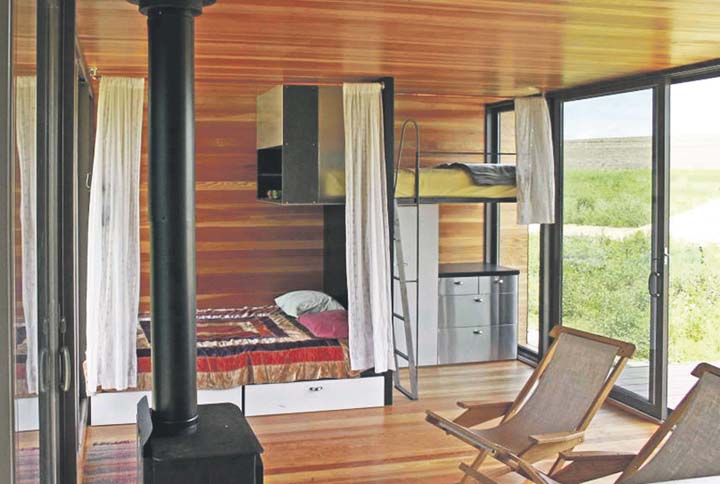Downsizing or downscaling, which means to design or produce in a smaller size, covers a lot of lifestyle facets—from building capsule closets to cutting out expenses in the pursuit of reducing the amount of possession one owns. Not surprisingly, this philosophy has also helped produce a new trend in housing, called the “tiny house” movement.

Tiny House Nation is an American reality TV series produced by FYI Network which follows renovation experts Zack Giffin and John Weisbarth in constructing and designing homes no larger than 500 square meters.
In an article published on Realtor.com in 2016, author Liz Alterman cited that while the exact number of tiny homes is yet unknown, it is reported that there are already more than 30 microcommunities that have sprouted across the US as of 2015.

entertainment convention HCon 2017.
Here in the Philippines, where people are becoming increasingly accustomed to living in small spaces, and where an average-sized home for a middle-class family range from 300 sq m to 800 sq m, the trend looks even more promising.
Given that tiny houses consume less square footage in most cases, it also means they have less property value, less maintenance cost, less cost of construction and even less expenditure on utilities, all of which translates to lesser carbon footprint. “I don’t live in a tiny house but what made me attracted to this movement was the environmental aspect of it. I like that by living in a place with a smaller footprint, you’re going to have a smaller environmental footprint, as well,” Weisbarth said.
The cost of building tiny homes varies depending on what type of house you are going to build and what materials are going to use. There are tiny houses that you can hitch to a car (houses on wheels) that are ideal for people who want to own a home that they can bring with them when, say, a desire for a new environment hits.
For permanent occupancy, there are tiny houses built just like traditional houses and trailer homes.
However, when it comes to trailer or container homes, homemakers need to allot a piece of land as certain real-estate laws and prohibitions delimit the space or area where such homes can be put.
Typically, a 20-feet shipping container will cost you around P60,000 to P70,000 locally, and the cost of renovation also varies depending on the customization you want. You can go far as buying two shipping containers and transforming them into a single-house unit.
“Anytime you can build with two trailers, it provides you with an opportunity to do this really nice thing where you can build a space in between those spaces that you can turn into a courtyard or a really nice outside area,” Weisbarth said.
Of course, embracing this tiny house movement demands everything from maximizing storage spaces to carefully decluttering unnecessary home items and even keepsakes. The fun part is the sense of versatility in terms of design and the thought process that goes in having to cram everything you need in a limited area. Think crown moldings turned into shoe racks, do-it-yourself platform storage beds, fold-down desks and turning staircases into book shelves.
As for purging sentimental valuables, Weisbarth had this to say: “What I try to remind people is that you don’t really miss a thing. What you miss are the memories associated with it, but these don’t go away just because the item goes away.”
The Tiny House Nation host also agreed that while the miniature house fad seemed temporary at the onset, it has now grown into the mainstream phenomenon we know today. Weisbarth said even celebrities are already embracing this trend, which is showing sustained and even growing popularity.
No doubt, there will be people who will argue that building a miniature house would be a difficult fit in the Philippine setting, the philosophy of decluttering and downsizing is what has made Tiny House Nation a must-see for viewers. Owning a small condominium, which can range from 20 sq m for a studio to 80 sq m for a two-bedroom affair, poses as an alternative option to “living small”.
Giffin said: “It’s in the pursuit of happiness and living within your means, that has really been the interest of the movement. I think what our show has done is it has shown to a much larger audience that these small spaces can be elegant, as well as very functional—that it’s not a downgrade.” He added, “In the end, it’s really about figuring out the individual needs of each person and what it is they’re hoping to get out of the tiny house. As my partner Zach here always says, a tiny house is a tool. And so we try to figure out what you’re going to use this tool for and that’s how we design houses.”
When asked about the probability of them designing tiny houses in the Philippines, Giffin and Weisbarth were both enthusiastic: “Well, first I’d put an air conditioner in it,” Giffin said, no doubt only in half-jest. “I would absolutely love to come back to the Philippines to build a house. I feel like in the US, where homes have gotten so large, a lot of places in the world have really been refined to utilize small spaces for a long time. In addition to coming here to build, I’d like to come here to learn.”
Weisbarth added in conclusion: “Absolutely. So far, we’ve only done it domestically in the US; it’s such a big country, so many regions. The inspiration from where we happen to be is always really exciting. So I can only imagine doing it here, given the new culture and new inspirations.”


































1 comment
Dear Sir:
I have been a follower of your series, Tiny House Nation. My brother saw this article ard got interested with the possibility of trying it in our land in the Philippines. We are of a low income family but would wish for a possibility of developing our home and land with your ideas in mind. Thank you very much for thinking about our country and the possibility it will bring for your company and our progress.
Respectfully yours,
Iris Guerra
Chicago, IL